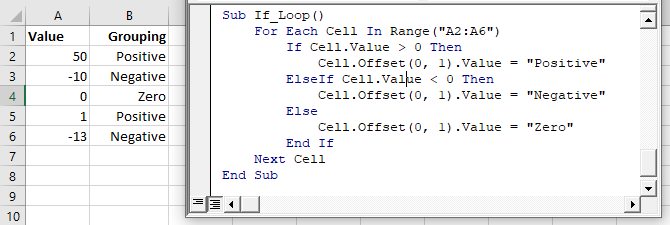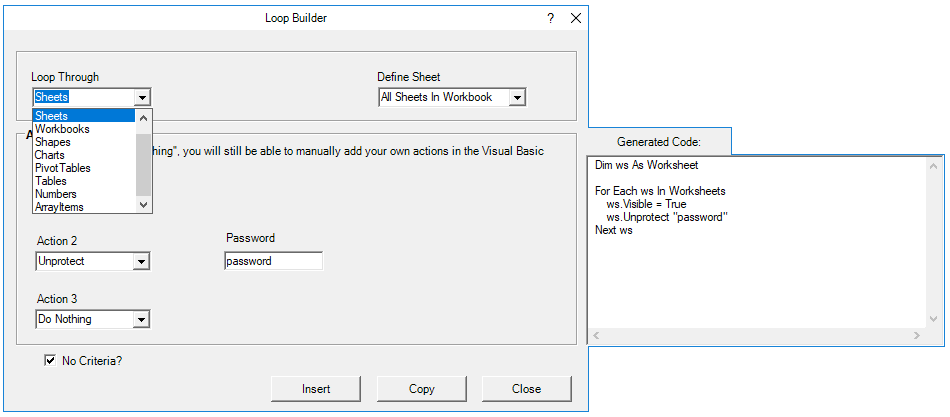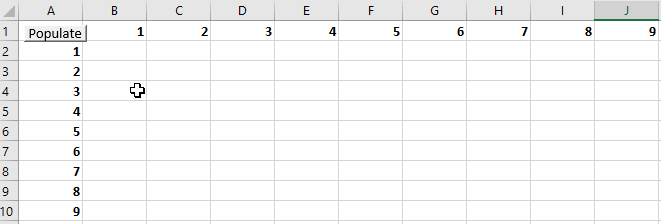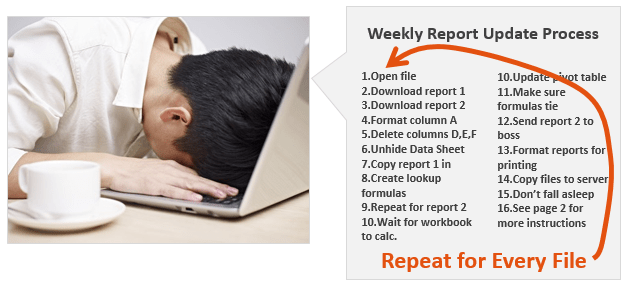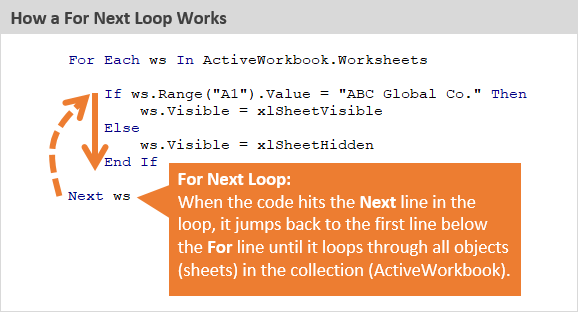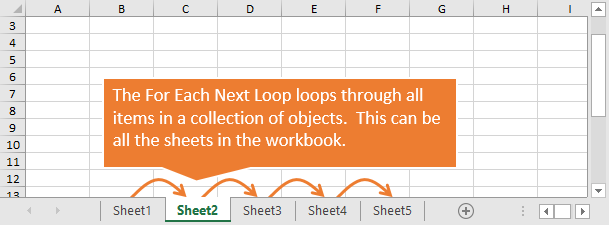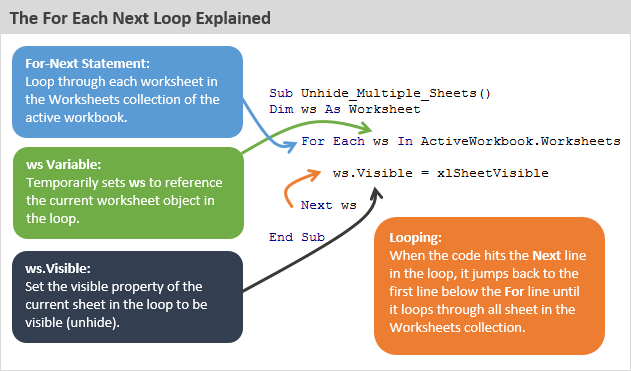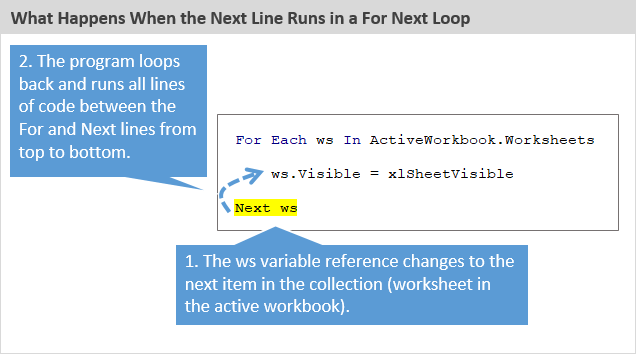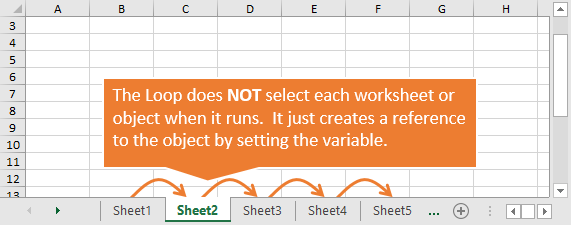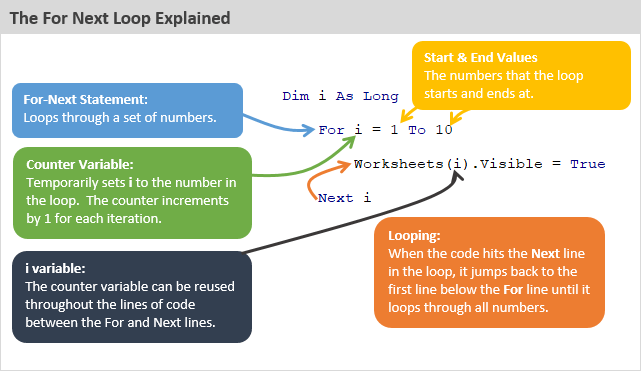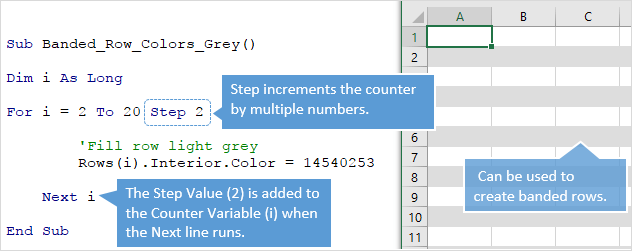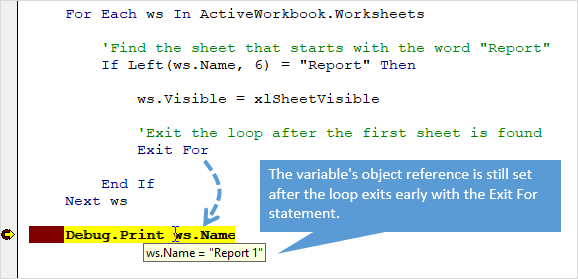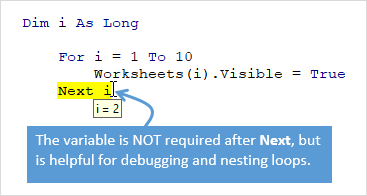In this Article
- VBA Loop Quick Examples
- For Each Loops
- For Next Loops
- Do While Loops
- Do Until Loops
- VBA Loop Builder
- VBA For Next Loop
- For Loop Syntax
- For Loop Step
- For Loop Step – Inverse
- Nested For Loop
- Exit For
- Continue For
- VBA For Each Loop
- For Each Cell in Range
- For Each Worksheet in Workbook
- For Each Open Workbook
- For Each Shape in Worksheet
- For Each Shape in Each Worksheet in Workbook
- For Each – IF Loop
- VBA Do While Loop
- Do While
- Loop While
- VBA Do Until Loop
- Do Until
- Loop Until
- Exit Do Loop
- End or Break Loop
- More Loop Examples
- Loop Through Rows
- Loop Through Columns
- Loop Through Files in a Folder
- Loop Through Array
- Loops in Access VBA
To work effectively in VBA, you must understand Loops.
Loops allow you to repeat a code block a set number of times or repeat a code block on a each object in a set of objects.
First we will show you a few examples to show you what loops are capable of. Then we will teach you everything about loops.
VBA Loop Quick Examples
For Each Loops
For Each Loops loop through every object in a collection, such as every worksheet in workbook or every cell in a range.
Loop Through all Worksheets in Workbook
This code will loop through all worksheets in the workbook, unhiding each sheet:
Sub LoopThroughSheets()
Dim ws As Worksheet
For Each ws In Worksheets
ws.Visible = True
Next
End SubLoop Through All Cells in Range
This code will loop through a range of cells, testing if the cell value is negative, positive, or zero:
Sub If_Loop()
Dim Cell as Range
For Each Cell In Range("A2:A6")
If Cell.Value > 0 Then
Cell.Offset(0, 1).Value = "Positive"
ElseIf Cell.Value < 0 Then
Cell.Offset(0, 1).Value = "Negative"
Else
Cell.Offset(0, 1).Value = "Zero"
End If
Next Cell
End SubFor Next Loops
Another type of “For” Loop is the For Next Loop. The For Next Loop allows you to loop through integers.
This code will loop through integers 1 through 10, displaying each with a message box:
Sub ForLoop()
Dim i As Integer
For i = 1 To 10
MsgBox i
Next i
End SubDo While Loops
Do While Loops will loop while a condition is met. This code will also loop through integers 1 through 10, displaying each with a message box.
Sub DoWhileLoop()
Dim n As Integer
n = 1
Do While n < 11
MsgBox n
n = n + 1
Loop
End SubDo Until Loops
Conversely, Do Until Loops will loop until a condition is met. This code does the same thing as the previous two examples.
Sub DoUntilLoop()
Dim n As Integer
n = 1
Do Until n >= 10
MsgBox n
n = n + 1
Loop
End SubWe will discuss this below, but you need to be extremely careful when creating Do While or Do Until loops so that you don’t create a never ending loop.
VBA Loop Builder
This is a screenshot of the “Loop Builder” from our Premium VBA Add-in: AutoMacro. The Loop Builder allows you to quickly and easily build loops to loop through different objects, or numbers. You can perform actions on each object and/or select only objects that meet certain criteria.
The add-in also contains many other code builders, an extensive VBA code library, and an assortment of coding tools. It’s a must have for any VBA developer.
Now we will cover the different types of loops in depth.
VBA Coding Made Easy
Stop searching for VBA code online. Learn more about AutoMacro — A VBA Code Builder that allows beginners to code procedures from scratch with minimal coding knowledge and with many time-saving features for all users!
Learn More
VBA For Next Loop
For Loop Syntax
The For Next Loop allows you to repeat a block of code a specified number of times. The syntax is:
[Dim Counter as Integer]
For Counter = Start to End [Step Value]
[Do Something]
Next [Counter]Where the items in brackets are optional.
- [Dim Counter as Long] – Declares the counter variable. Required if Option Explicit is declared at the top of your module.
- Counter – An integer variable used to count
- Start – The start value (Ex. 1)
- End – The end value (Ex. 10)
- [Step Value] – Allows you to count every n integers instead of every 1 integer. You can also go in reverse with a negative value (ex. Step -1)
- [Do Something] – The code that will repeat
- Next [Counter] – Closing statement to the For Next Loop. You can include the Counter or not. However, I strongly recommend including the counter as it makes your code easier to read.
If that’s confusing, don’t worry. We will review some examples:
Count to 10
This code will count to 10 using a For-Next Loop:
Sub ForEach_CountTo10()
Dim n As Integer
For n = 1 To 10
MsgBox n
Next n
End SubFor Loop Step
Count to 10 – Only Even Numbers
This code will count to 10 only counting even numbers:
Sub ForEach_CountTo10_Even()
Dim n As Integer
For n = 2 To 10 Step 2
MsgBox n
Next n
End SubNotice we added “Step 2”. This tells the For Loop to “step” through the counter by 2. We can also use a negative step value to step in reverse:
VBA Programming | Code Generator does work for you!
For Loop Step – Inverse
Countdown from 10
This code will countdown from 10:
Sub ForEach_Countdown_Inverse()
Dim n As Integer
For n = 10 To 1 Step -1
MsgBox n
Next n
MsgBox "Lift Off"
End SubDelete Rows if Cell is Blank
I’ve most frequently used a negative step For-Loop to loop through ranges of cells, deleting rows that meet certain criteria. If you loop from the top rows to the bottom rows, as you delete rows you will mess up your counter.
This example will delete rows with blank cells (starting from the bottom row):
Sub ForEach_DeleteRows_BlankCells()
Dim n As Integer
For n = 10 To 1 Step -1
If Range("a" & n).Value = "" Then
Range("a" & n).EntireRow.Delete
End If
Next n
End SubNested For Loop
You can “nest” one For Loop inside another For Loop. We will use Nested For Loops to create a multiplication table:
Sub Nested_ForEach_MultiplicationTable()
Dim row As Integer, col As Integer
For row = 1 To 9
For col = 1 To 9
Cells(row + 1, col + 1).Value = row * col
Next col
Next row
End SubExit For
The Exit For statement allows you to exit a For Next loop immediately.
You would usually use Exit For along with an If Statement, exiting the For Next Loop if a certain condition is met.
For example, you might use a For Loop to find a cell. Once that cell is found, you can exit the loop to speed up your code.
This code will loop through rows 1 to 1000, looking for “error” in column A. If it’s found, the code will select the cell, alert you to the found error, and exit the loop:
Sub ExitFor_Loop()
Dim i As Integer
For i = 1 To 1000
If Range("A" & i).Value = "error" Then
Range("A" & i).Select
MsgBox "Error Found"
Exit For
End If
Next i
End SubImportant: In the case of Nested For Loops, Exit For only exits the current For Loop, not all active Loops.
Continue For
VBA does not have the “Continue” command that’s found in Visual Basic. Instead, you will need to use “Exit”.
AutoMacro | Ultimate VBA Add-in | Click for Free Trial!
VBA For Each Loop
The VBA For Each Loop will loop through all objects in a collection:
- All cells in a range
- All worksheets in a workbook
- All shapes in a worksheet
- All open workbooks
You can also use Nested For Each Loops to:
- All cells in a range on all worksheets
- All shapes on all worksheets
- All sheets in all open workbooks
- and so on…
The syntax is:
For Each Object in Collection
[Do Something]
Next [Object]Where:
- Object – Variable representing a Range, Worksheet, Workbook, Shape, etc. (ex. rng)
- Collection – Collection of objects (ex. Range(“a1:a10”)
- [Do Something] – Code block to run on each object
- Next [Object] – Closing statement. [Object] is optional, however strongly recommended.
For Each Cell in Range
This code will loop through each cell in a range:
Sub ForEachCell_inRange()
Dim cell As Range
For Each cell In Range("a1:a10")
cell.Value = cell.Offset(0,1).Value
Next cell
End SubFor Each Worksheet in Workbook
This code will loop through all worksheets in a workbook, unprotecting each sheet:
Sub ForEachSheet_inWorkbook()
Dim ws As Worksheet
For Each ws In Worksheets
ws.Unprotect "password"
Next ws
End SubFor Each Open Workbook
This code will save and close all open workbooks:
Sub ForEachWB_inWorkbooks()
Dim wb As Workbook
For Each wb In Workbooks
wb.Close SaveChanges:=True
Next wb
End SubAutoMacro | Ultimate VBA Add-in | Click for Free Trial!
For Each Shape in Worksheet
This code will delete all shapes in the active sheet.
Sub ForEachShape()
Dim shp As Shape
For Each shp In ActiveSheet.Shapes
shp.Delete
Next shp
End Sub
For Each Shape in Each Worksheet in Workbook
You can also nest For Each Loops. Here we will loop through all shapes in all worksheets in the active workbook:
Sub ForEachShape_inAllWorksheets()
Dim shp As Shape, ws As Worksheet
For Each ws In Worksheets
For Each shp In ws.Shapes
shp.Delete
Next shp
Next ws
End SubFor Each – IF Loop
As we’ve mentioned before, you can use an If statement within a loop, performing actions only if certain criteria is met.
This code will hide all blank rows in a range:
Sub ForEachCell_inRange()
Dim cell As Range
For Each cell In Range("a1:a10")
If cell.Value = "" Then _
cell.EntireRow.Hidden = True
Next cell
End SubVBA Do While Loop
The VBA Do While and Do Until (see next section) are very similar. They will repeat a loop while (or until) a condition is met.
The Do While Loop will repeat a loop while a condition is met.
Here is the Do While Syntax:
Do While Condition
[Do Something]
LoopWhere:
- Condition – The condition to test
- [Do Something] – The code block to repeat
You can also set up a Do While loop with the Condition at the end of the loop:
Do
[Do Something]
Loop While ConditionWe will demo each one and show how they differ:
AutoMacro | Ultimate VBA Add-in | Click for Free Trial!
Do While
Here is the Do While loop example we demonstrated previously:
Sub DoWhileLoop()
Dim n As Integer
n = 1
Do While n < 11
MsgBox n
n = n + 1
Loop
End SubLoop While
Now let’s run the same procedure, except we will move the condition to the end of the loop:
Sub DoLoopWhile()
Dim n As Integer
n = 1
Do
MsgBox n
n = n + 1
Loop While n < 11
End SubVBA Do Until Loop
Do Until Loops will repeat a loop until a certain condition is met. The syntax is essentially the same as the Do While loops:
Do Until Condition
[Do Something]
Loopand similarly the condition can go at the start or the end of the loop:
Do
[Do Something]
Loop Until ConditionDo Until
This do Until loop will count to 10, like our previous examples
Sub DoUntilLoop()
Dim n As Integer
n = 1
Do Until n > 10
MsgBox n
n = n + 1
Loop
End SubAutoMacro | Ultimate VBA Add-in | Click for Free Trial!
Loop Until
This Loop Until loop will count to 10:
Sub DoLoopUntil()
Dim n As Integer
n = 1
Do
MsgBox n
n = n + 1
Loop Until n > 10
End SubExit Do Loop
Similar to using Exit For to exit a For Loop, you use the Exit Do command to exit a Do Loop immediately
Exit DoHere is an example of Exit Do:
Sub ExitDo_Loop()
Dim i As Integer
i = 1
Do Until i > 1000
If Range("A" & i).Value = "error" Then
Range("A" & i).Select
MsgBox "Error Found"
Exit Do
End If
i = i + 1
Loop
End SubEnd or Break Loop
As we mentioned above, you can use the Exit For or Exit Do to exit loops:
Exit ForExit DoHowever, these commands must be added to your code before you run your loop.
If you are trying to “break” a loop that’s currently running, you can try pressing ESC or CTRL + Pause Break on the keyboard. However, this may not work. If it doesn’t work, you’ll need to wait for your loop to end or, in the case of an endless loop, use CTRL + ALT + Delete to force close Excel.
This is why I try to avoid Do loops, it’s easier to accidentally create an endless loop forcing you to restart Excel, potentially losing your work.
More Loop Examples
AutoMacro | Ultimate VBA Add-in | Click for Free Trial!
Loop Through Rows
This will loop through all the rows in a column:
Public Sub LoopThroughRows()
Dim cell As Range
For Each cell In Range("A:A")
If cell.value <> "" Then MsgBox cell.address & ": " & cell.Value
Next cell
End SubLoop Through Columns
This will loop through all columns in a row:
Public Sub LoopThroughColumns()
Dim cell As Range
For Each cell In Range("1:1")
If cell.Value <> "" Then MsgBox cell.Address & ": " & cell.Value
Next cell
End Sub
Loop Through Files in a Folder
This code will loop through all files in a folder, creating a list:
Sub LoopThroughFiles ()
Dim oFSO As Object
Dim oFolder As Object
Dim oFile As Object
Dim i As Integer
Set oFSO = CreateObject("Scripting.FileSystemObject")
Set oFolder = oFSO.GetFolder("C:Demo)
i = 2
For Each oFile In oFolder.Files
Range("A" & i).value = oFile.Name
i = i + 1
Next oFile
End SubLoop Through Array
This code will loop through the array ‘arrList’:
For i = LBound(arrList) To UBound(arrList)
MsgBox arrList(i)
Next iThe LBound function gets the “lower bound” of the array and UBound gets the “upper bound”.
Loops in Access VBA
Most of the examples above will also work in Access VBA. However, in Access, we loop through the Recordset Object rather than the Range Object.
Sub LoopThroughRecords()
On Error Resume Next
Dim dbs As Database
Dim rst As Recordset
Set dbs = CurrentDb
Set rst = dbs.OpenRecordset("tblClients", dbOpenDynaset)
With rst
.MoveLast
.MoveFirst
Do Until .EOF = True
MsgBox (rst.Fields("ClientName"))
.MoveNext
Loop
End With
rst.Close
Set rst = Nothing
Set dbs = Nothing
End SubЦикл For… Next в VBA Excel, его синтаксис и описание отдельных компонентов. Примеры использования цикла For… Next.
Цикл For… Next в VBA Excel предназначен для выполнения группы операторов необходимое количество раз, заданное управляющей переменной цикла — счетчиком. При выполнении цикла значение счетчика после каждой итерации увеличивается или уменьшается на число, указанное выражением оператора Step, или, по умолчанию, на единицу. Когда необходимо применить цикл к элементам, количество которых и индексация в группе (диапазон, массив, коллекция) неизвестны, следует использовать цикл For Each… Next.
|
For counter = start To end [ Step step ] [ statements ] [ Exit For ] [ statements ] Next [ counter ] |
|
For счетчик = начало To конец [ Step шаг ] [ операторы ] [ Exit For ] [ операторы ] Next [ счетчик ] |
В квадратных скобках указаны необязательные атрибуты цикла For… Next.
Компоненты цикла For… Next
| Компонент | Описание |
|---|---|
| counter | Обязательный атрибут. Числовая переменная, выполняющая роль счетчика, которую еще называют управляющей переменной цикла. |
| start | Обязательный атрибут. Числовое выражение, задающее начальное значение счетчика. |
| end | Обязательный атрибут. Числовое выражение, задающее конечное значение счетчика. |
| Step* | Необязательный атрибут. Оператор, указывающий, что будет задан шаг цикла. |
| step | Необязательный атрибут. Числовое выражение, задающее шаг цикла. Может быть как положительным, так и отрицательным. |
| statements | Необязательный** атрибут. Операторы вашего кода. |
| Exit For | Необязательный атрибут. Оператор выхода из цикла до его окончания. |
| Next [ counter ] | Здесь counter — необязательный атрибут. Это то же самое имя управляющей переменной цикла, которое можно здесь не указывать. |
*Если атрибут Step отсутствует, цикл For… Next выполняется с шагом по умолчанию, равному 1.
**Если не использовать в цикле свой код, смысл применения цикла теряется.
Примеры циклов For… Next
Вы можете скопировать примеры циклов в свой модуль VBA, последовательно запускать их на выполнение и смотреть результаты.
Простейший цикл
Заполняем десять первых ячеек первого столбца активного листа Excel цифрами от 1 до 10:
|
Sub test1() Dim i As Long For i = 1 To 10 Cells(i, 1) = i Next End Sub |
Простейший цикл с шагом
В предыдущий цикл добавлен оператор Step со значением 3, а результаты записываем во второй столбец:
|
Sub test2() Dim i As Long For i = 1 To 10 Step 3 Cells(i, 2) = i Next End Sub |
Цикл с отрицательными аргументами
Этот цикл заполняет десять первых ячеек третьего столбца в обратной последовательности:
|
Sub test3() Dim i As Long For i = 0 To —9 Step —1 Cells(i + 10, 3) = i + 10 Next End Sub |
Увеличиваем размер шага до -3 и записываем результаты в четвертый столбец активного листа Excel:
|
Sub test4() Dim i As Long For i = 0 To —9 Step —3 Cells(i + 10, 4) = i + 10 Next End Sub |
Вложенный цикл
Внешний цикл последовательно задает индексы первых десяти строк активного листа, а вложенный цикл складывает числа в первых четырех ячейках строки с текущем индексом и записывает сумму в ячейку пятого столбца. Перед запуском вложенного цикла с накопительным сложением, пятую ячейку соответствующей строки обнуляем, чтобы в случае нахождения в ней какого-либо числа, оно не прибавилось к итоговой сумме.
|
Sub test5() Dim i1 As Long, i2 As Long For i1 = 1 To 10 ‘Пятой ячейке в строке i1 присваиваем 0 Cells(i1, 5) = 0 For i2 = 1 To 4 Cells(i1, 5) = Cells(i1, 5) + Cells(i1, i2) Next Next End Sub |
Выход из цикла
В шестой столбец активного листа запишем названия десяти животных, конечно же, с помощью цикла For… Next:
|
Sub test6() Dim i As Long For i = 1 To 10 Cells(i, 6) = Choose(i, «Медведь», «Слон», «Жираф», «Антилопа», _ «Крокодил», «Зебра», «Тигр», «Ящерица», «Лев», «Бегемот») Next End Sub |
Следующий цикл будет искать в шестом столбце крокодила, который съел галоши. В ячейку седьмого столбца цикл, пока не встретит крокодила, будет записывать строку «Здесь был цикл», а когда обнаружит крокодила, запишет «Он съел галоши» и прекратит работу, выполнив команду Exit For. Это будет видно по ячейкам рядом с названиями животных ниже крокодила, в которых не будет текста «Здесь был цикл».
|
Sub test7() Dim i As Long For i = 1 To 10 If Cells(i, 6) = «Крокодил» Then Cells(i, 7) = «Он съел галоши» Exit For Else Cells(i, 7) = «Здесь был цикл» End If Next End Sub |
Результат работы циклов For… Next из примеров:
Результат работы циклов For… Next
Такие данные на активном листе Excel вы получите, если последовательно запустите на выполнение в редакторе VBA все семь подпрограмм из примеров, демонстрирующих работу циклов For… Next.
Цикл с дробными аргументами
Атрибуты start, end и step могут быть представлены числом, переменной или числовым выражением:
|
For i = 1 To 20 Step 2 For i = a To b Step c For i = a — 3 To 2b + 1 Step c/2 |
В результате вычисления значения переменной вне цикла или выражения внутри его может получиться дробный результат. VBA Excel округлит его до целого числа, используя бухгалтерское округление:
|
‘Значения атрибутов до округления For i = 1.5 To 10.5 Step 2.51 ‘Округленные значения атрибутов For i = 2 To 10 Step 3 |
Старайтесь не допускать попадания в тело цикла For… Next неокругленных значений аргументов, чтобы не получить непредсказуемые результаты его выполнения. Если без дробных чисел не обойтись, а необходимо использовать обычное округление, применяйте в коде VBA функцию рабочего листа WorksheetFunction.Round для округления числа перед использованием его в цикле For… Next.
This post provides a complete guide to the standard VBA For Loop and the VBA For Each Loop.
If you are looking for information about the VBA While and VBA Do Loop then go here.
If you want some quick info about the For loops then check out the Quick Guide table in the section below.
If you are looking for information on a particular topic then check out the Table of Contents below.
“History is about loops and continuums” – Mike Bidlo.
Related Links for the VBA For Loop
The Complete Guide to Ranges in Excel VBA.
The Complete Guide to Copying Data in Excel VBA.
VBA Do While Loop.
A Quick Guide to the VBA For Loop
| Loop format | Description | Example |
|---|---|---|
| For … Next | Run 10 times | For i = 1 To 10 Next |
| For … Next | Run 5 times. i=2,4, 6 etc. | For i = 2 To 10 Step 2 Next |
| For … Next | Run in reverse order | For i = 10 To 1 Step -1 Debug.Print i Next |
| For … Next | Go through Collection | For i = 1 To coll.Count Debug.Print coll(i) Next |
| For … Next | Go through array | For i = LBound(arr) To UBound(arr) Debug.Print arr(i) Next i |
| For … Next | Go through 2D array | For i = LBound(arr) To UBound(arr) For j = LBound(arr,2) To UBound(arr,2) Debug.Print arr(i, j) Next j Next i |
| For Each … Next | Go through Collection | Dim item As Variant For Each item In coll Debug.Print item Next item |
| For Each … Next | Go through array | Dim item As Variant For Each item In arr Debug.Print item Next item |
| For Each … Next | Go through 2D array | Dim item As Variant For Each item In arr Debug.Print item Next item |
| For Each … Next | Go through Dictionary | Dim key As Variant For Each key In dict.Keys Debug.Print key, dict(key) Next key |
| Both types | Exit Loop | For i = 1 To 10 If Cells(i,1) = «found» Then Exit For End If Next i |
The VBA For Loop Webinar
If you are a member of the website, click on the image below to view the webinar for this post.
(Note: Website members have access to the full webinar archive.)
Introduction to the VBA For Loop
Loops are by far the most powerful component of VBA. They are the rocket fuel of your Macros. They can perform tasks in milliseconds that would take humans hours. They also dramatically reduce the lines of code your applications need.
For Loops have been part of all major programming languages since they were first used with Fortan in 1957.
If you have never used loops before then this post is a great place to start. It provides an in-depth guide to loops, written in plain English without the jargon.
Let’s start with a very important question – what are loops and why do we need them?
What are VBA For Loops?
A loop is simply a way of running the same lines of code a number of times. Obviously running the same code over and over would give the same result.
So what is important to understand is that the lines of code normally contain a variable that changes slightly each time the loop runs.
For example, a loop could write to cell A1, then cell A2, A3 and so on. The slight change each time is the row.
Let’s look at a simple example.
VBA For Loop Example 1
The following code prints the values 1 to 5 in the Immediate Window(Ctrl + G to view).
Debug.Print 1 Debug.Print 2 Debug.Print 3 Debug.Print 4 Debug.Print 5
The Immediate Window
If you have not used the Immediate Window before then this section will get you up to speed quickly.
The function Debug.Print writes values to the Immediate Window. To view this window select View->Immediate Window from the menu( the shortcut is Ctrl + G)
VBA For Loop Example 2
Now imagine we want to print out the numbers 1 to 20. We would need to add 15 more lines to the example above.
However, using a loop we only need to write Debug.Print once.
For i = 1 To 20 Debug.Print i Next i
The output is:
Output
If we needed print the numbers 1 to 1000 then we only need to change the 20 to 1000.
Normally when we write code we would use a variable instead of a number like 20 or 1000. This gives you greater flexibility. It allows you to decide the number of times you wish to run the loop when the code is running. The following example explains this.
VBA For Loop Example 3
A common task in Excel is read all the rows with with data.
The way you approach this task is as follows
- Find the last row with data
- Store the value in variable
- Use the variable to determine how many times the loop runs
Using a variable in the loop makes your code very flexible. Your will work no matter how many rows there are.
Let’s have a look at an example. Imagine you receive a sheet with a list of fruit types and their daily sales. You want to count the number of Oranges sold and this list will vary in size depending on sales.
The following screenshot shows an example of this list
Sample Data of Fruit Sales
We can use the code to count the oranges
' https://excelmacromastery.com/ Sub CountFruit() ' Get the last row with text Dim LastRow As Long LastRow = Sheet1.Cells(Sheet1.Rows.Count, 1).End(xlUp).Row Dim i As Long, Total As Long ' Use LastRow in loop For i = 2 To LastRow ' Check if cell has text "Orange" If Sheet1.Cells(i, 1).Value = "Oranges" Then ' Add value in column B to total Total = Total + Sheet1.Cells(i, 2).Value End If Next i ' Print total Debug.Print "Total oranges sold was:"; Total End Sub
You can try this code for yourself. Change the number of fruit items and you will see that the code still works fine.
If you were to increase the number fruit items to a large value like 10,000 then you will hardly notice the difference in the time it takes to run – almost instantly.
Loops are super fast. This is what makes them so powerful. Imagine performing a manual task on 10,000 cells. It would take a considerable amount of time.
Advantages of the VBA For Loop
4To conclude this section we will list the major advantages of using loops
- They reduce the lines code you need
- They are flexible
- They are fast
In the next sections we will look at the different types of loops and how to use them.
The Standard VBA For Loop
The VBA For loop is the most common loop you will use in Excel VBA. The For Loop is used when you can determine the number of times it will be run. For example, if you want to repeat something twenty times.
YouTube Video For Loop
Check out this YouTube Video of the For Loop:
Get the workbook and code for this video here
Format of the Standard VBA For Loop
The Standard VBA For Loop has the following format:
For <variable> = <start value> to <end value>
Next <variable>
The start and end values can be variables. Also the variable after Next is optional but it is useful and it makes it clear which for loop it belongs to.
How a For Loop Works
Let’s look at a simple for loop that prints the numbers 1 to 3
Dim i As Long For i = 1 To 3 Debug.Print i Next i
How this code works is as follows
i is set to 1
The value of i(now 1) is printed
i is set to 2
The value of i(now 2) is printed
i is set to 3
The value of i(now 3) is printed
If we did not use a loop then the equivalent code would be
Dim i As Long i = i + 1 Debug.Print i i = i + 1 Debug.Print i i = i + 1 Debug.Print i
The i = i + 1 line is used to add 1 to i and is a common way in programming to update a counter.
Using Step with the VBA For Loop
You can see that i is increased by one each time. This is the default. You can specify this interval using Step keyword.
The next example shows you how to do this:
' Prints the even numbers i.e. 2,4,6,8 ... 20 For i = 2 To 20 Step 2 Debug.Print i Next i
You can use a negative number with Step which will count in reverse
' Prints the even numbers in reverse i.e. 20,18,16,14 ... 2 For i = 20 To 2 Step -2 Debug.Print i Next i
Note: if Step is positive then your starting number must be lower than you ending number. The following loop will not run because the starting number 20 is greater than 10. VBA therefore, thinks it has already reached the target value 10.
' Will not run as starting number already greater than 10 For i = 20 To 10 Step 1 Debug.Print i Next i
If Step is negative then the start number must be greater than the end number.
Exit the For Loop
Sometimes you may want to leave the loop earlier if a certain condition occurs. For example if you read bad data.
You can use Exit For to automatically leave the loop as shown in the following code
For i = 1 To 1000 ' If cell is blank then exit for If Cells(i, 1) = "" Then MsgBox "Blank Cell found - Data error" Exit For End If Next i
Using the VBA For Loop with a Collection
The For loop can also be used to read items in a Collection.
In the following example, we display the name of all the open workbooks
Dim i As Long For i = 1 To Workbooks.Count Debug.Print Workbooks(i).FullName Next i
Using Nested For Loops
Sometimes you may want to use a loop within a loop. An example of this would be where you want to print the names of the worksheets of each open workbook.
The first loop would go through each workbook. Each time this loop runs it would use a second loop to go through all the worksheets of that workbook. It is actually much easier to do than it sounds.
The following code shows how:
' https://excelmacromastery.com/ Sub ListWorksheets() Dim i As Long, j As Long ' First Loop goes through all workbooks For i = 1 To Workbooks.Count ' Second loop goes through all the worksheets of workbook(i) For j = 1 To Workbooks(i).Worksheets.Count Debug.Print Workbooks(i).Name + ":" + Worksheets(j).Name Next j Next i End Sub
This works as follows:
The first loop sets i to 1
The second loop then uses the workbook at 1 to go through the worksheets.
The first loop sets i to 2
The second loop then uses the workbook at 2 to go through the worksheets.
and so on
It the next section we will use a For Each loop to perform the same task. You will find the For Each version much easier to read.
The VBA For Each Loop
The VBA For Each loop is used to read items from a collection or an array. We can use the For Each loop to access all the open workbooks. This is because Application.Workbooks is a collection of open workbooks.
This is a simple example of using the For Each Loop
Dim wk As Workbook For Each wk In Workbooks Debug.Print wk.FullName Next wk
Format of the VBA For Each Loop
You can see the format of the VBA for each loop here(See Microsoft For Each Next documentation):
For Each <variable> in <collection>
Next <variable>
To create a For Each loop we need a variable of the same type that the collection holds. In the example here we created a variable of type Workbook.
If the collection has different types of items we can declare the variable as a variant.
VBA contains a collection called Sheets. This is a collection of sheets of type Worksheet(normal) and Chart(when you move a chart to be a full sheet). To go through this collection you would declare the variable as a Variant.
The following code uses For Each to print out the name of all the sheets in the current workbook
Dim sh As Variant For Each sh In ThisWorkbook.Sheets Debug.Print sh.Name Next sh
Order of Items in the For Loop
For Each goes through items in one way only.
For example, if you go through all the worksheets in a workbook it will always go through from left to right. If you go through a range it will start at the lowest cell e.g. Range(“A1:A10”) will return A1,A2,A3 etc.
This means if you want any other order then you need to use the For loop.
Both loops in the following example will read the worksheets from left to right:
' Both loops read the worksheets from left to right Dim wk As Worksheet For Each wk In ThisWorkbook.Worksheets Debug.Print wk.Name Next Dim i As Long For i = 1 To ThisWorkbook.Worksheets.Count Debug.Print ThisWorkbook.Worksheets(i).Name Next
As you can see the For Each loop is neater to write. However if you want to read the sheets in any other order e.g. right to left then you have to use the for loop:
' Reading the worksheets from right to left Dim i As Long For i = ThisWorkbook.Worksheets.Count To 1 Step -1 Debug.Print ThisWorkbook.Worksheets(i).Name Next
Using the VBA For Each Loop With Arrays
One thing to keep in my is that the For Each loop is that it is read-only when you use it with arrays.
The following example demonstrates this:
' https://excelmacromastery.com/ Sub UseForEach() ' Create array and add three values Dim arr() As Variant arr = Array("A", "B", "C") Dim s As Variant For Each s In arr ' Changes what s is referring to - not value of array item s = "Z" Next ' Print items to show the array has remained unchanged For Each s In arr Debug.Print s Next End Sub
In the first loop we try to assign s to “Z”. When happens is that s is now referring the string “Z” and no longer to the item in the array.
In the second loop we print out the array and you can see that none of the values have changed.
When we use the For Loop we can change the array item. If we change the previous code to use the For Loop you it will change all the array values to “Z”
' https://excelmacromastery.com/ Sub UsingForWithArray() ' Create array and add three values Dim arr() As Variant arr = Array("A", "B", "C") Dim i As Long For i = LBound(arr) To UBound(arr) ' Changes value at position to Z arr(i) = "Z" Next ' Print items to show the array values have change For i = LBound(arr) To UBound(arr) Debug.Print arr(i) Next End Sub
If your Collection is storing Objects the you can change the items using a For Each loop.
Using Nested For Each Loops
We saw already that you can have a loop inside other loops. Here is the example from above:
' https://excelmacromastery.com/ Sub ListWorksheets() Dim i As Long, j As Long ' First Loop goes through all workbooks For i = 1 To Workbooks.Count ' Second loop goes through all the worksheets of workbook(i) For j = 1 To Workbooks(i).Worksheets.Count Debug.Print Workbooks(i).Name + ":" + Worksheets(j).Name Next j Next i End Sub
This time we will use the For Each loop to perform the same task:
' https://excelmacromastery.com/ Sub ReadAllWorksheets() Dim wk As Workbook, sh As Worksheet ' Read each workbook For Each wk In Workbooks ' Read each worksheet in the wk workbook For Each sh In wk.Worksheets ' Print workbook name and worksheet name Debug.Print wk.Name + ": " + sh.Name Next sh Next wk End Sub
As you can see this is a neater way of performing this task than using the For Loop:
This code run as follows:
- Get the first Workbook from the Workbooks collection
- Go through all the worksheets in this workbook
- Print the workbook/worksheet details
- Get the next workbooks in the collection
- Repeat steps 2 to 3
- Continue until no more workbooks are left in the collection
How to Loop Through a Range
In Excel VBA, the most common use of a For Loop is to read through a range.
Imagine we have the data set in the screenshot below. Our task is to write code that will read through the data and copy the amounts to the column J. We are only going to copy amounts that are greater than 200,000.
The following example shows how we do it:
' Read through an Excel Range using the VBA For Loop ' https://excelmacromastery.com/ Sub ForLoopThroughRange() ' Get the worksheet Dim sh As Worksheet Set sh = ThisWorkbook.Worksheets("Sheet1") ' Get the Range Dim rg As Range Set rg = sh.Range("A1").CurrentRegion ' Delete existing output sh.Range("J1").CurrentRegion.ClearContents ' Set the first output row Dim row As Long row = 1 ' Read through all the rows using the For Loop Dim i As Long For i = 2 To rg.Rows.Count ' Check if amount is greater than 200000 If rg.Cells(i, 4).Value > 200000 Then ' Copy amount to column m sh.Cells(row, "J").Value = rg.Cells(i, 4).Value ' Move to next output row row = row + 1 End If Next i End Sub
This is a very basic example of copying data using Excel VBA. If you want a complete guide to copying data using Excel VBA then check out this post
Summary of the VBA For Loops
The Standard VBA For Loop
- The For loop is slower than the For Each loop.
- The For loop can go through a selection of items e.g. 5 to 10.
- The For loop can read items in reverse e.g. 10 to 1.
- The For loop is not as neat to write as the For Each Loop especially with nested loops.
- To exit a For loop use Exit For.
The VBA For Each Loop
- The For Each loop is faster than the For loop.
- The For Each loop goes through all items in the collectionarray.
- The For Each loop can go through items in one order only.
- The For Each loop is neater to write than a For Loop especially for nested loops.
- To exit a For Each loop use Exit For.
What’s Next?
Free VBA Tutorial If you are new to VBA or you want to sharpen your existing VBA skills then why not try out the The Ultimate VBA Tutorial.
Related Training: Get full access to the Excel VBA training webinars.
(NOTE: Planning to build or manage a VBA Application? Learn how to build 10 Excel VBA applications from scratch.)
В этом учебном материале вы узнаете, как использовать Excel оператор FOR … NEXT для создания цикла FOR в VBA с синтаксисом и примерами.
Описание
Оператор Microsoft Excel FOR … NEXT используется для создания цикла FOR, чтобы вы могли выполнять код VBA определенное количество раз. Оператор FOR … NEXT является встроенной функцией Excel, которая относится к категории логических функций. Её можно использовать как функцию VBA в Excel.
В качестве функции VBA вы можете использовать эту функцию в коде макроса, который вводится через редактор Microsoft Visual Basic Editor.
Синтаксис
Синтаксис для создания цикла FOR с использованием оператора FOR … NEXT в Microsoft Excel:
For counter = start To end [Step increment] {…statements…}Next [counter]
Аргументы или параметры
- counter
- Переменная счетчика цикла.
- start
- Начальное значение для
counter. - end
- Конечное значение для
counter. - increment
- По желанию. Значение
counterувеличивается при каждом проходе цикла. Это может быть положительное или отрицательное число.
Если не указано, по умолчанию будет приращение 1, так что каждый проход через цикл увеличиваетcounterна 1. - statement
- Операторы кода для выполнения каждого прохода через цикл.
Возвращаемое значение
Оператор FOR … NEXT создает цикл FOR в VBA.
Примечание
- См. также инструкцию WHILE … WEND, чтобы создать цикл WHILE в VBA.
Применение
- Excel для Office 365, Excel 2019, Excel 2016, Excel 2013, Excel 2011 для Mac, Excel 2010, Excel 2007, Excel 2003, Excel XP, Excel 2000
Тип функции
- Функция VBA
Пример (как функция VBA)
Оператор FOR … NEXT может использоваться только в коде VBA в Microsoft Excel.
Давайте посмотрим, как создать цикл FOR в Microsoft Excel, начиная с одинарного цикла, двойной цикл и тройной цикл, а затем исследуем, как изменить значение, используемое для увеличения счетчика при каждом прохождении цикла.
Одинарный цикл
Простейшей реализацией цикла FOR является использование оператора FOR … NEXT для создания одного цикла. Это позволит вам повторять код VBA фиксированное количество раз, например:
|
Sub Single_Loop_Example Dim LCounter As Integer For LCounter = 1 To 5 MsgBox (LCounter) Next LCounter End Sub |
В этом примере цикл FOR управляется переменной LCounter. Он будет повторяться 5 раз, начиная с 1 и заканчивая 5. Каждый раз внутри цикла он будет отображать окно сообщения со значением переменной LCounter. Этот код отобразит 5 окон сообщений со следующими значениями: 1, 2, 3, 4 и 5.
Одинарный цикл — изменение приращения
По умолчанию цикл FOR увеличивает свой счетчик цикла на 1, но это можно настроить. Вы можете использовать Step increment, чтобы изменить значение, используемое для увеличения счетчика. Приращение цикла FOR может иметь как положительные, так и отрицательные значения.
Положительное приращение
Давайте сначала рассмотрим пример того, как увеличить счетчик цикла FOR на положительное значение.
Например:
|
Sub Increment_Positive_Example Dim LCounter As Integer For LCounter = 1 To 9 Step 2 MsgBox LCounter Next LCounter End Sub |
В этом примере мы использовали шаг 2 в цикле FOR, чтобы изменить приращение на 2. Это означает, что цикл FOR будет начинаться с 1, увеличиваться на 2 и заканчиваться на 9. Код будет отображать 5 окон сообщений со следующими значениями: 1, 3, 5, 7 и 9.
Отрицательное приращение
Теперь давайте посмотрим, как увеличить счетчик цикла FOR на отрицательное значение.
Например:
|
Sub Increment_Negative_Example Dim LCounter As Integer For LCounter = 50 To 30 Step —5 MsgBox LCounter Next LCounter End Sub |
Когда вы увеличиваете на отрицательное значение, вам нужно, чтобы начальное число был с более высоким значением, а конечное число — с меньшим значением, поскольку цикл FOR будет вести обратный отсчет. Итак, в этом примере цикл FOR будет начинаться с 50, увеличиваться на -5 и заканчиваться на 30. Код отобразит 5 окон сообщений со следующими значениями: 50, 45, 40, 35 и 30.
Двойной цикл
Теперь давайте рассмотрим пример создания двойного цикла FOR в Microsoft Excel.
Например:
|
Sub Double_Loop_Example Dim LCounter1 As Integer Dim LCounter2 As Integer For LCounter1 = 1 To 4 For LCounter2 = 8 To 9 MsgBox LCounter1 & «-« & LCounter2 Next LCounter2 Next LCounter1 End Sub |
Здесь у нас есть 2 цикла FOR. Внешний цикл FOR управляется переменной LCounter1. Внутренний цикл FOR управляется переменной LCounter2. В этом примере внешний цикл FOR будет повторяться 4 раза (начиная с 1 и заканчивая 4), а внутренний цикл FOR будет повторяться 2 раза (начиная с 8 и заканчивая 9). Во внутреннем цикле код будет каждый раз отображать окно сообщения со значением LCounter1-LCounter2. Таким образом, в этом примере будут отображаться 8 окон сообщений со следующими значениями: 1-8, 1-9, 2-8, 2-9, 3-8, 3-9, 4-8 и 4-9.
Тройной цикл
Теперь давайте рассмотрим пример того, как создать тройной цикл FOR в Microsoft Excel.
Например:
|
Sub Triple_Loop_Example Dim LCounter1 As Integer Dim LCounter2 As Integer Dim LCounter3 As Integer For LCounter1 = 1 To 2 For LCounter2 = 5 To 6 For LCounter3 = 7 To 8 MsgBox LCounter1 & «-« & LCounter2 & «-« & LCounter3 Next LCounter3 Next LCounter2 Next LCounter1 End Sub |
В приведенном выше примере у нас есть 3 цикла FOR. Самый внешний цикл FOR управляется переменной LCounter1. Следующий цикл FOR управляется переменной LCounter2. Самый внутренний цикл FOR управляется переменной LCounter3. В этом примере самый внешний цикл FOR будет повторяться 2 раза (начиная с 1 и заканчивая 2), следующий цикл FOR будет повторяться 2 раза (начиная с 5 и заканчивается на 6), а самый внутренний цикл FOR будет повторяться 2 раза (начиная с 7 и заканчивая 8). Внутри самого внутреннего цикла код будет каждый раз отображать окно сообщения со значением LCounter1-LCounter2 -LCounter3. Этот код отображает 8 окон сообщений со следующими значениями: 1-5-7, 1-5-8, 1-6-7, 1-6-8, 2-5-7, 2-5-8, 2- 6-7 и 2-6-8.
Bottom line: The For Next Loops are some of the most powerful VBA macro coding techniques for automating common tasks in Excel. This article explains how the loop works to repeat actions on a collection of items, which saves us a ton of time with our jobs.
Skill level: Intermediate
The Power of VBA Loops
In Excel we spend a lot of time repeating simple tasks. This could be actions like: formatting multiple ranges, unhiding multiple sheets, copying and pasting to several workbooks, apply filters to multiple tables or pivot tables, replacing values, updating formulas, etc.
Can you think of a few tasks where you had to repeat the same process over and over again?
These tasks can be extremely time consuming and BORING!
Fortunately, there is a way out. We can use loops in our VBA macros to repeat actions very quickly. Tasks that can take hours to do manually can be completed in a matter of seconds with a loop.
The For Next Loop is the most common type of loop that helps us with these repetitive jobs. In this article we will look at the two types of For Next Loops.
Download the Example File
Download the free Excel file that contains examples of macros with the For Next Loop.
Download a PDF version of the article for printing.
How Does the For Next Loop Work?
The For Next Loop allows us to loop through a collection of items in Excel. The collection can be a collection of objects or a list of numbers.
Examples of collections of objects include:
- Cells in a range.
- Worksheets in a workbook.
- Open workbooks on the computer.
- Pivot tables in a worksheet.
- Pivot fields in a pivot table.
- Shapes on a worksheet.
- And any other object you interact with in Excel.
The job of the For Next Loop is to perform the same actions (lines of code) on each item in the collection.
The example below contains a For Next Loop that loops through each worksheet in the workbook and unhides each sheet. The loop starts at the first item in the collection (the first sheet in the workbook), and performs the line(s) of code between the For and Next lines for each item in the collection (every sheet in the workbook).
Sub Unhide_Multiple_Sheets()
Dim ws As Worksheet
For Each ws In ActiveWorkbook.Worksheets
ws.Visible = xlSheetVisible
Next ws
End Sub
Of course we can use logical statements like If statements to test properties and conditions before performing the actions. The following macro only unhides sheets that have the phrase “ABC Global Co.” in cell A1 of each sheet, and hides all other sheets.
Sub Unhide_Report_Sheets()
Dim ws As Worksheet
For Each ws In ActiveWorkbook.Worksheets
If ws.Range("A1").Value = "ABC Global Co." Then
ws.Visible = xlSheetVisible
Else
ws.Visible = xlSheetHidden
End If
Next ws
End Sub
The Two Types of For Next Loops
There are really two types of For Next Loops.
- For Each Next Loops loop through a collection of items.
- For Next Loops loop through a set of numbers.
Let’s take a look at how each works.
The For Each Next Loop: Loops Through a Collection of Items
As we saw above, the The For Each Next Loop allows us to loop through a collection of items or objects. This is probably the most common loop we use in Excel because we are working with collections of objects. Again, these collections are the cells in a range, worksheets in a workbook, pivot tables in a worksheet, etc.
We will use the example of writing a For Each Next Loop to loop through all the worksheets in a workbook.
There are 4 basic steps to writing a For Each Next Loop in VBA:
- Declare a variable for an object.
- Write the For Each Line with the variable and collection references.
- Add line(s) of code to repeat for each item in the collection.
- Write the Next line to close the loop.
Let’s take a look at each of these steps in detail.
Step 1 – Declare a Variable for an Object
We first need to declare a variable that will temporarily store a reference to the object.
The Dim line at the top of the macro declares a variable as an object. In this case the object is a worksheet. We can create any variable name we want as long as it is not the same as another reference in VBA. “ws” is the most common variable name for a worksheet object, but you can change this.
Dim ws As Worksheet
Step 2 – The For Each Line
Next we will write the For Each statement. This is the first line of code in the loop.
For Each ws In ActiveWorkbook.Worksheets
The first two words are For Each. Then we type the variable name, followed by the word In Finally, we specify where the collection exists. In this case we want to loop through all the worksheets in the ActiveWorkbook. So, we type ActiveWorkbook.Worksheets. That line references all the worksheets in the ActiveWorkbook.
If you want to loop through worksheets of a specific workbook, then you can use the Workbooks property to reference that workbook by name.
For Each ws In Workbooks("Book2.xlsx").Worksheets
Just remember that the workbook you reference has to be open before the For Next line of code runs. Of course, we can use the Workbooks.Open method to open the workbook as well.
Step 3 – Add Code to Repeat for Each Iteration
After the For Each line, we add the line(s) of code that will be performed on each sheet. In this example we just have one line of code that unhides the sheet.
ws.Visible = xlSheetVisible
In this line of code we are using the ws variable to reference the current worksheet in the loop. When the loop runs, it sets a temporary reference to the ws variable for each iteration in the loop.
This would be the same as if we were to set the ws variable to a specific sheet using the following line of code.
Set ws = Worksheets(1)
However, we do NOT need this line with the For Each Next Loop. The loop takes care of setting the variable for us for each iteration in the loop.
For the first iteration in the loop, the ws is set to Worksheets(1). In the next iteration, ws is set to Worksheets(2). This continues as the loop iterates through all sheets in the workbook. This is very powerful because we can reuse the variable to reference the worksheet several times within the the loop.
Step 4 – The Next Line Loops Back
The final line of code in the loop is the Next line.
Next ws
When the macro hits this line of code it does two things:
- First, it changes the variable reference to the next item in the collection. In this example, the ws variable is changed to reference the next sheet in the workbook.
- Second, it loops back up to the run the line of code directly below the For Each line. It then runs all the lines of code between the For Each and Next lines in top to bottom order.
When the last item in the collection (worksheet in the workbook) is reached, the looping stops, and the macro continues on to the next line of code below the Next line.
What Order Does the For Each Loop Run In?
The For Each Loop always starts at the first item in the collection and loops through to the last item in the order they appear in Excel. This is based on the index number of the items in the collection. Here are some examples of the order the loop runs in for common objects.
- Worksheets: Starts at the first sheet tab in the workbook and loops to the last in the order the tabs are displayed in the workbook.
- Workbooks: Starts at the first workbook that was opened and loops in the order that workbooks were opened. Workbooks are assigned an index number as they are opened.
- Cells: Loops left-to-right, then down. Starts in the first cell in the range and loops to the next column in the same row, then goes to the next row.
- Tables & Pivot Tables: Starts with the first object that was create in the sheet and loops in the order the objects were created. This same principle is true for other objects you create in sheets like shapes, charts, slicers, etc.
Items/Objects Are NOT Selected in the Loop
It’s important to note that when we loop through a collection of objects, each object is NOT selected in Excel.
The loop creates a reference to the item/object with the variable. The variable is temporarily set to a reference of the object. The object is NOT selected and does NOT necessarily become the active object. To select the object we can use the Select or Activate methods. You would also have to make sure the objects parent object(s) are selected first. Checkout my article on the Excel Object Model and Object Hierarchy in VBA for more on this.
The Next Loop: Loops Through a Set of Numbers
We can also use the For Next Loop to loop through a set of numbers. This can be useful when we are looping through userform controls, arrays, or if we want to loop through a collection backwards.
The basic operation of the For Next Loop is the same as the For Each Loop. The difference is the format of the For line.
Step 1 – Declare a Variable for a Number
To loop through a set of numbers we first need to declare a variable to a whole number data type. We can use Integer or Long integer.
Dim i As Long
The variable is referred to as the Counter because it increments or counts up/down for each iteration in the loop.
A side note on Long: The Long (integer) data type holds a bigger number than Integer. It takes up more memory, but today’s computer have so much memory that it’s no longer a problem. We can use Long variables all the time. The letter L looks like the number 1 in VBA, so I’m now using i as the variable name even though I use Long as the data type. This is all a matter of personal preference and you can name the variable whatever you want.
Step 2 – Write the For Statement
Next we write the For statement. The basic construct is the keyword For, followed by the variable name (counter), then equals sign, start value To end value.
For i = 1 To 10
The start and end values can be referenced as numbers, or we can use integer/long variables in their place.
For i = iStart To iEnd
We can also use properties of objects that return a number.
For i = 1 To ActiveWorkbook.Worksheets.Count
That line of code would return the number of sheets in the active workbook. However, it is NOT looping through each worksheet. The loop is just looping through a set of numbers. We have to create a reference to a worksheet with the counter variable (i) as the index number of the Worksheets property. Step 3 shows this reference.
Step 3 – Add Code that Repeats for Each Iteration
The rest of the loop functions the same as the For Each loop. We can add lines between the For and Next lines that will run for each iteration of the loop. The counter variable can be used multiple times in these lines of code.
Worksheets(i).Visible = True
Step 4 – The Next Line Increments the Number & Loops Back
Finally, we add the Next line at the bottom.
Next i
When the macro runs it will set the variable equal to the first number in the For line. When the macro hits the Next line, it will add 1 to the value of the variable, or count up. So, i = 2 in the second iteration of the loop. It continues to loop until the last number in the loop is reached.
By default, 1 is added to the variable counter for each iteration in the loop. This is called the Step Value, and we can control the value of each step in the counter. The Step value is added to the end of the For line. The following line will add 2 to the counter for each iteration in the loop.
For i = 2 To 20 Step 2
If you wanted to shade every other row in a sheet, you might use a loop like this.
Looping Backwards
We can also use the Step Value to loop backwards by specifying a negative number.
For i = 100 To 1 Step -1
Notice that the Start Value is now the larger number and the End Value is the smaller number. The loops starts at 100 (Start Value) and subtracts 1 from the counter variable (Step -1) for each iteration in the loop until it gets to 1 (End Value).
The Step keyword is optional. If you do not specify it then VBA assumes a Step value of 1.
Looping backwards is great if you are deleting items. I will write a separate post on this, but the general idea is that when we are looping through a collection and deleting items, the size of the collection gets smaller as items are deleted. The loop will typically hit an error once it gets to the 10th item, when there are now only 9 items in the collection. Looping backwards prevents this potential error.
Exiting the Loop Early
Typically the loop will iterate through all items in the collection, then continue on to the next line of code below the Next line. However, we can stop the loop early with an Exit For statement.
Exit For
The following macro uses the Exit For statement to exit the loop after the first sheet that starts with the word “Report” is found an unhidden.
Sub Unhide_First_Sheet_Exit_For()
'Unhides the first sheet that contain a specific phrase
'in the sheet name, then exits the loop.
Dim ws As Worksheet
For Each ws In ActiveWorkbook.Worksheets
'Find the sheet that starts with the word "Report"
If Left(ws.Name, 6) = "Report" Then
ws.Visible = xlSheetVisible
'Exit the loop after the first sheet is found
Exit For
End If
Next ws
End Sub
The ws variable retains the reference to the worksheet after the loop is exited early, and can be used again in the code below the loop.
Variable Not Required After Next Keyword
You might have noticed that I added the variable after the Next keyword at the bottom of the loop in the examples above.
Next ws
Next i
This is NOT required, and you might not see it in other examples you find on the web. However, I like to include the variable after Next for two reasons.
- We can use it when debugging code to see the value of the variable by hovering the mouse over the variable when the code is stopped.
- It makes it easier to understand which For line the Next line is connected to. This is especially true when you have multiple loops or nested loops in your macros.
Therefore, I recommend adding the variable after the Next keyword as a best practice. A little extra work up front will save time & headache in the future. Trust me! 😉
Macro Code Examples of VBA For Loops
Here are additional articles with macros that use at least one For Next Loop.
3 Ways to Unhide Multiple Sheets in Excel + VBA Tutorial
Automatic Default Number Formatting in Excel Pivot Tables
3 Tips to Save and Close All Open Excel Workbook Files + Macro
The SUBTOTAL Metrics Macro – Create a Summary Table of All Function Types
How to Add a Table of Contents Image Gallery Sheet to Your Excel Files
Hide & Unhide (Filter) Columns with a Slicer or Filter Drop-down Menu
Filter a Pivot Table or Slicer for the Most Recent Date or Period
How to Make Your Excel Dashboards Resize for Different Screen Sizes
Convert Pivot Table to SUMIFS Formulas + Free VBA Macro
VBA Macro to Hide All Columns That Contain a Value in a Cell
How to Repeat Tasks with VBA Code – Looping – Great article with lots of examples from my friend Chris Newman at The Spreadsheet Guru.
What Task Do You Want To Loop?
I hope that article helps get you started with loops. Don’t forget to download the free Excel file that contains the code samples.
Loops are definitely an intermediate coding technique that force us to go beyond the macro recorder. Unfortunately, the macro recorded cannot create loops. However, this is a skill that you will be able to use over and over again throughout your career to automate simple and complex tasks. Understanding how to use loops will give you magical powers with Excel.
Please leave a comment below with a task that you want to automate with a loop. Thank you! 🙂

